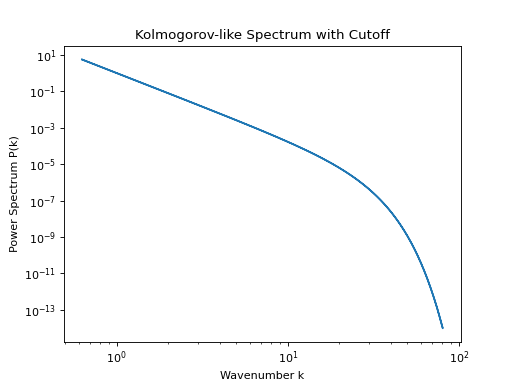pisces.math_utils.random_fields.generate_kolmogorov_power_spectrum#
- pisces.math_utils.random_fields.generate_kolmogorov_power_spectrum(amplitude: float = 1.0, k0: float = 1.0, k_cut: float | None = None) Callable[source]#
Generate a Kolmogorov-like turbulence power spectrum function.
The Kolmogorov turbulence scaling predicts an energy spectrum \(E(k) \propto k^{-5/3}\), which corresponds to a power spectrum \(P(k) \propto k^{-11/3}\) in three dimensions. This function implements
\[P(k) = A \left(\frac{k}{k_0}\right)^{-11/3} \exp\!\left[-\left(\frac{k}{k_\mathrm{cut}}\right)^2\right],\]where the exponential cutoff is optional and only applied if \(k_\mathrm{cut}\) is specified.
- Parameters:
- Returns:
A function
P(kx, ky, ...)that takes arrays of wavenumber components and returns the Kolmogorov-like spectrum.- Return type:
Callable
Examples
from pisces.math_utils.random_fields import generate_kolmogorov_power_spectrum L, n = 10.0, 256 k_grid = np.fft.fftfreq(n, d=L/n) * 2 * np.pi k_mag = np.abs(k_grid) power_spectrum = generate_kolmogorov_power_spectrum(amplitude=1.0, k0=1.0, k_cut=20.0) ps_array = power_spectrum(k_mag) import matplotlib.pyplot as plt plt.loglog(k_mag[1:], ps_array[1:]) # skip k=0 plt.xlabel('Wavenumber k') plt.ylabel('Power Spectrum P(k)') plt.title('Kolmogorov-like Spectrum with Cutoff') plt.show()
(
Source code,png,hires.png,pdf)